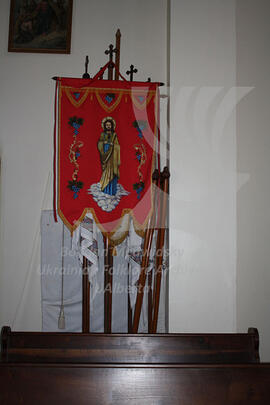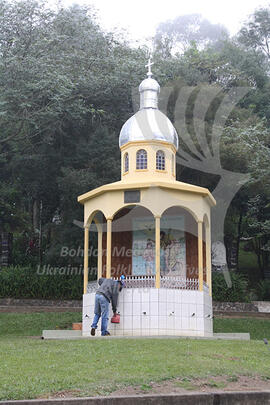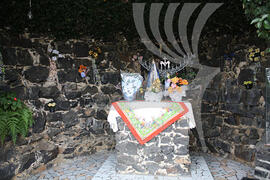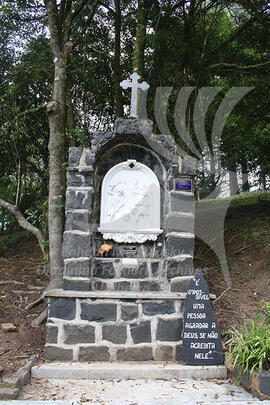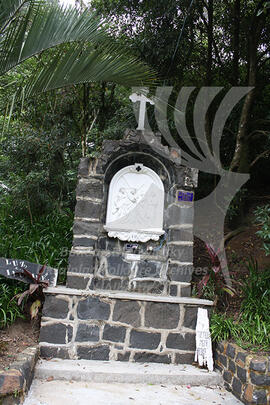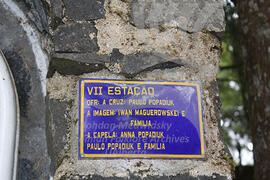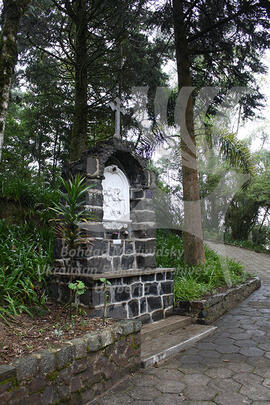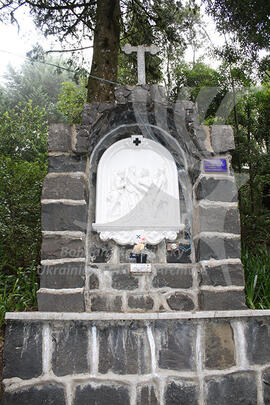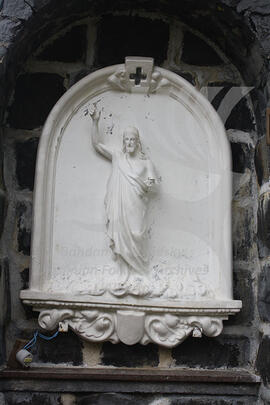Church banner, embroidery of the Sagrada familia Iracema Church, Santa Catarina.
Exterior of the Sagrada familia Iracema Church, Santa Catarina with flower garden on the foreground
The well as a part of the religious architectural complex Sagrada familia Church and Via Sacra (Iracema, Santa Catarina). A driver of a truck made a stop near the well in order to drink a water and fill in a plastic can
The well as a part of the religious architectural complex Sagrada familia Church and Via Sacra (Iracema, Santa Catarina). A picture inside the well made of tile. A plot: the baptism of Jesus Christ by St. John. A sign: "Ty - mii Syn liubyi, tebe ia vpodobav"
The element of the grotto on the bottom of Via Sacra (Iracema, Santa Catarina) - ritual table, sculpture, flowers, embroidery
The element of the grotto on the bottom of Via Sacra (Iracema, Santa Catarina) - statuette of Jesus Christ
The element of Via Sacra: a sign with the name of donors for the 1st station of Via Sacra. The sign is placed on the Via sacra 1sth Station monument
Via Sacra memorial: 3rd station monument, general view. The monument made of stones with the stone cross on the top and carved of white marble picture in the alcove. (Small architectural item)
The element of Via Sacra: a sign on the piece of wood: placed on the basement of the 3rd Station monument E imposivel uma pessoa agradar a deus se nao agredita nele
Via Sacra memorial: 4th station monument, general view. The monument made of stones with the stone cross on the top and carved of white marble picture in the alcove. (Small architectural item)
Via Sacra memorial: 6th station of the Cross carved of marble picture: Veronica Wipes Jesus' Face. A sign in Ukrainian: VI Statsiia. "Veronika obtyraie lytse Isusa." The sign in Portuguese
Via Sacra memorial: 7th station of the Cross, carved of marble picture: Jesus Falls the Second Time. A sign in Ukrainian: VI Statsiia. "Isus padaie vdruhe pid khrestom." The sign in Portuguese
The element of Via Sacra memorial: a sign with the names of donors for the 7th station of Via Sacra. The sign is placed on the Via sacra 7th Station monument. Names: Paulo Popadiuk, Iwan Maguerowskei e familia, Anna Popadiuk, Paulo Popadiuk e familia.
Via Sacra memorial: 9th station monument, general view. The monument made of stones with the stone cross on the top and carved of white marble picture in the alcove. (Small architectural item)
The element of Via Sacra memorial: a sign with the names of donors for the 9th station of Via Sacra. The sign is placed on the Via sacra 9th Station monument. Names: Dmytro Tzap e familia
Via Sacra memorial: 10th station monument, general view. The monument made of stones with the stone cross on the top and carved of white marble picture in the alcove. (Small architectural item)
Via Sacra memorial: 10th station of the Cross, carved of marble picture: Jesus is Stripped. Sign: X Statsiia. (In Ukrainian). The sign in Portuguese
The element of Via Sacra memorial: a sign with the names of donors for the 11th station of Via Sacra. The sign is placed on the Via sacra 11th Station monument. Names: Danylo Sydorak, Mychailo Kossar, Francisco Werka, Petro Cymbalistei e familia, Nestor Sydorak e familia, Danylo Sydorak e familia
Via Sacra memorial: 15th station of the Cross, carved of marble picture: Resurrected Jesus
This item contains an interview with Mrs. Gauss, who was born in 1898, her maiden name was Zeider (Cyder?). Her mother originally
came from Württemberg. Her family was working on the land, were not rich. There were the only Germans in their village besides one shepherd. There was also a Lutheran church and a German school (education lasted 7 years). Children started going to school when they became seven years old. At the age of fifteen there usually was a confirmation and then they were working for their father until they got married and created own family. Her village was in the Melitopol district and there was a school in Eichenfeld. In general there were 32 family entities in the village each of them were farming and producing goods. Collectivization started in 1917-1918. The relationship with Russian people was good. There usually were many seasonal Russian workers in the German village. German children learned German and Russian languages in the school. Most of the Russian language they learned from Russian workers. Not many girls extended their school education as mothers needed them at home for help. There were eight children in her family, some families had ten, some six. Russians usually were very poor, had many children and not much land. Pomeschiki had more land. Mrs Gauss remembers how people once all together bought land from pomeschik and created a village. Germans were forced to go to the Russian army as well. Tsar Nicolai was loved by Germans. There was a school which educated doctors as well. She was 16 years old when the war started, Germans were forced to join the Russian army, many were captured in Germany and afterwards returned back to Russia. Her village didn´t have problems during the war, they had a cooperative and the living was good. She visited Krym once many years later. Memories on her village during the revolution. People came from Moscow, took what they wanted and went further to other villages.
